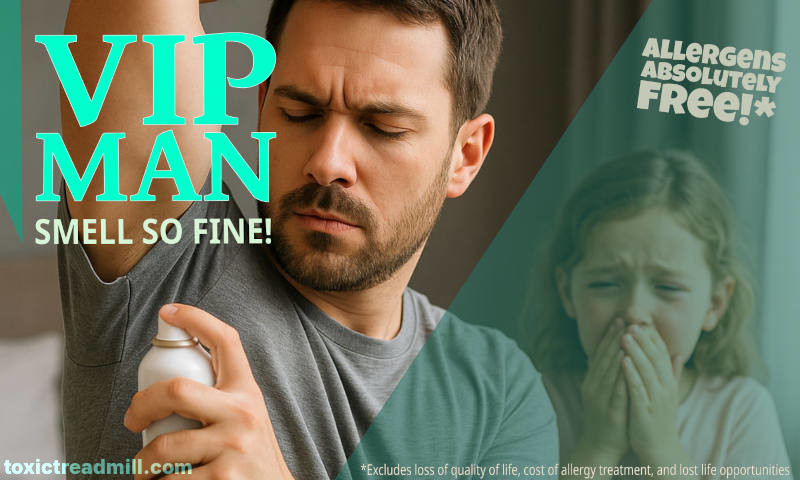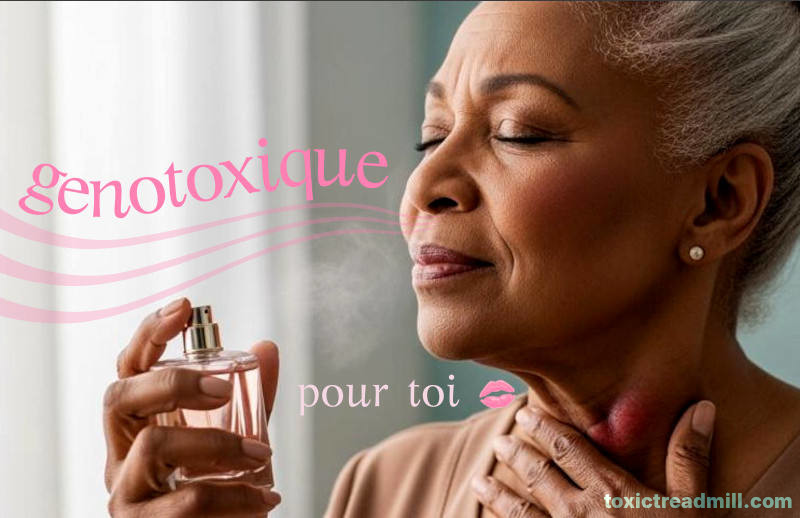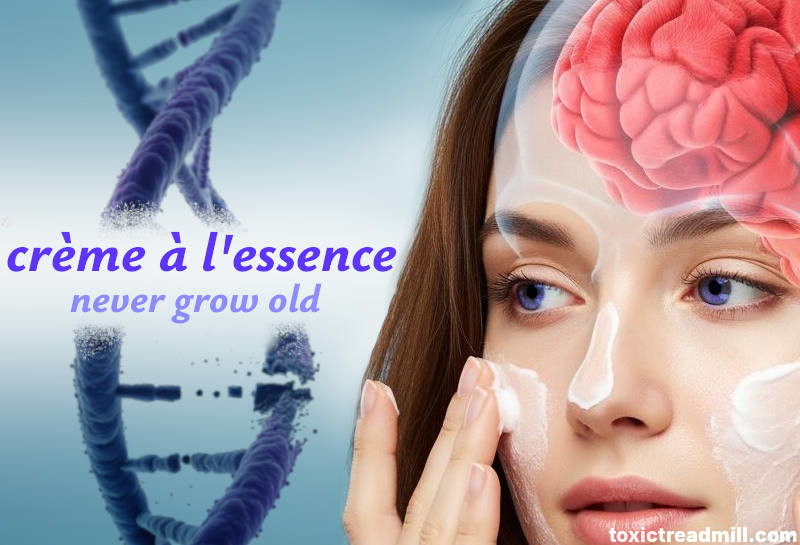Toxic Treadmill
Evidence for a Poisoned Planet
Hazardous Ingredients in Bathing, Washing, & Skin Care
The increasing global use of personal care products (PCPs) for bathing, washing, and skin care has prompted growing concern over ingredients that pose significant health risks—not only due to their direct toxicological action on human tissues, but also through long‐term exposure. Despite their widespread acceptance and daily use, increasing scientific evidence suggests that many chemicals in these products can be absorbed through the skin, interfere with hormonal pathways, and persist in the environment, allowing cumulative exposures. Moreover, the presence of fraudulent substitutes or ingredients that are either banned in other jurisdictions or known to persist in the environment exacerbates the potential public health burden. Imported products, knock-off products, and products bought on holiday, may not comply with national regulations. Additionally, mislabelling and misrepresentation by manufacturers or retailers may often go undetected due to ignorance, and a lack of funding for regulatory testing and enforcement.

Harmful Chemical Constituents in Personal Care Products
A wide range of toxicants have been identified in PCPs. These chemicals fall into several categories that include preservatives, plasticizers (phthalates), antimicrobial compounds, heavy metals, UV filters, fragrance compounds, and compounds resulting from manufacturing by-products. Various studies have shown that the use of PCPs can result in chronic, low-level exposures to xenobiotics that may disrupt endocrine pathways, accumulate in fatty tissues, and eventually lead to diseases such as cancer, reproductive disorders, and neurodegenerative conditions.
Endocrine Disruptors
Parabens
These preservatives are widely used in cosmetics for their antimicrobial properties and cost-effectiveness. Parabens mimic estrogen and have been linked to endocrine disruption, potential breast cancer development, and reproductive abnormalities. Despite regulatory agencies in certain jurisdictions (e.g. UK, USA, Canada) considering them safe at low levels, data show that these chemicals penetrate the skin, accumulate in the body’s fatty tissues, and enhance chronic exposure risks.
Phthalates
Often utilized as plasticizers and fragrance fixatives in products such as nail polish, shampoos, and lotions, phthalates (including DBP, DEP, and DEHP) are now recognized for their endocrine-disrupting properties. Studies have linked phthalates to reproductive toxicity, altered hormone regulation, and diseases affecting families of endocrine-related conditions in both men and women. Moreover, bio-monitoring studies have noted that multiple metabolites of phthalates are detectable in nearly all human urine samples, highlighting the pervasiveness of exposure.
Triclosan
This antimicrobial agent, found in many soaps, toothpaste, and sanitizers, is associated with endocrine disruption as well as environmental persistence. Triclosan’s lipophilic nature facilitates its incorporation into bodily tissues, and its potential to form chloroform by-products during chlorination of water raises additional health risk concerns.
Carcinogens and Genotoxic Agents
Certain ingredients in personal care products have been directly linked to carcinogenesis and genotoxicity.
Formaldehyde and Formaldehyde-Releasers
These compounds are used as preservatives and stabilizers in products like nail polish and hair straightening formulations. Formaldehyde is a well-known human carcinogen and is associated with respiratory, skin, and nasal cancers, as well as potential systemic toxicity when absorbed over time.
Coal Tar Dyes and p-Phenylenediamine (PPD)
Coal tar dyes contain PPD, which has a documented association with non-Hodgkin’s lymphoma and a spectrum of reproductive and neurological disorders. Heavy metal contaminants occasionally found in these dyes further increase the risk of systemic toxicity.
Heavy Metals
Heavy metals such as lead, arsenic, cadmium, and mercury are sometimes detected as impurities in personal care products. Lead exposure, even at low levels, has been associated with neurotoxicity, liver and kidney dysfunction, and adverse developmental outcomes. Although there are regulatory limits for lead in some products (e.g., lipsticks), studies consistently report its presence in everyday PCPs due to contamination during manufacturing or use of contaminated raw materials.

Fragrances and Masked Chemicals
The term “fragrance” is a catch-all label on cosmetic products that may mask a mixture of undisclosed chemicals including phthalates and synthetic musks. Fragrance components can cause allergic reactions, respiratory irritation, and even potential endocrine disruption. The lack of transparency regarding the specific chemicals contained under the “fragrance” label hampers risk assessment and contributes to consumer exposure to potentially harmful substances. Marketing frequently with reference to naturally occurring plants and materials which resemble the fragrance of the product. However, it is commonplace for synthetic chemicals to be used in place of natural compounds.
Other Toxic Ingredients
Nanoparticles
Titanium dioxide and zinc oxide nanoparticles are increasingly used in sunscreen and cosmetic products for their UV-protective properties. While they offer cosmetic benefits, these nanoparticles have raised concerns because of their potential to penetrate the skin barrier, cause oxidative stress, and contribute to long-term systemic toxicity as well as environmental pollution.
Plastic Microbeads
Used for exfoliation in scrubs and cleansers, microbeads are now recognized as environmental pollutants. Being small enough to pass through wastewater treatment systems, these plastic particles accumulate in aquatic ecosystems alongside adsorbed toxic pollutants, posing risks to wildlife and potentially entering the human food chain.
Mechanisms of Toxicity and Human Health Implications
Many of the chemicals present in personal care products cause harm through a variety of biological mechanisms. Endocrine disruptors like parabens and phthalates interfere with hormonal signaling by mimicking natural hormones or by blocking receptor sites, which can lead to conditions ranging from infertility and reproductive abnormalities to an increased risk for hormone-dependent cancers.
Additionally, compounds such as formaldehyde and certain heavy metals are capable of causing direct DNA damage or interfering with cellular replication and repair mechanisms, leading to mutations and, over an extended period, the potential development of cancer.
Triclosan’s mechanism of toxicity may involve both endocrine disruption and an enhanced ability to induce oxidative stress in tissues, potentially leading to chronic inflammatory responses and possibly facilitating tumorigenesis.
Fragrance chemicals, especially when combined within “fragrance” mixtures, may also exert synergistic toxic effects that are not predictable from their individual properties, thereby complicating risk assessments.
Allergies
Allergenicity is a complex topic. Some people are far more susceptible than others due to factors such as genetic predisposition, sensitizing exposures, comorbid disease, overall toxic load, and physical stressors at the time of exposure. Additionally, factors such as the concentration of substance, and simultaneous exposures to other allergens, will influence whether, and to what extent, there is an allergic response. Allergies cause sufferers a significant health burden, and cost dearly in loss of quality of life, factors required for management and reduced exposure, and medication.
All of the following are known allergens frequently present in body sprays, perfumes, and personal wash products:
Preservatives
- Methylisothiazolinone (MIT)
- Methylchloroisothiazolinone (MCI)
- Parabens (e.g., Methylparaben, Propylparaben)
- Formaldehyde-releasing agents (e.g., DMDM Hydantoin, Imidazolidinyl Urea, Diazolidinyl Urea)
- Phenoxyethanol
Colorants and Dyes
- CI (Colour Index) Dyes (e.g., CI 19140, CI 42090)
- Tartrazine (CI 19140, also known as Yellow 5)
- Carmine (CI 75470)
UV Filters (in Some Products)
- Benzophenone-3 (Oxybenzone)
- Octocrylene
- Ethylhexyl Methoxycinnamate (Octinoxate)
Alcohols and Solvents
- Denatured Alcohol (Alcohol Denat.)
- Benzyl Alcohol (also a fragrance component)
Surfactants (in Soaps and Washes)
- Sodium Lauryl Sulfate (SLS)
- Sodium Laureth Sulfate (SLES)
Other Potential Allergens
- Propylene Glycol
- Cocamidopropyl Betaine
- Lanolin and Lanolin Alcohols
Fragrance Allergens (Naturally Occurring or Synthetic)
- Limonene
- Linalool
- Citral
- Citronellol
- Geraniol
- Eugenol
- Isoeugenol
- Farnesol
- Coumarin
- Cinnamal (Cinnamaldehyde)
- Benzyl Salicylate
- Benzyl Alcohol
- Benzyl Cinnamate
- Benzyl Benzoate
- Hexyl Cinnamal
- Amyl Cinnamal
- Cinnamyl alcohol
- Amylcinnamyl alcohol
- Alpha-isomethyl Ionone
- Hydroxycitronellal
- Evernia prunastri extract (Oakmoss extract)
- Evernia furfuracea extract (Tree moss extract)
- Anise Alcohol
- Methyl 2-octynoate
- Butylphenyl methylpropional (Lilial)
- Hydroxyisohexyl 3-cyclohexene carboxaldehyde (HICC) AKA Lyral
Fragrance allergens are frequently unspecified on labels; generic terms like 'fragrance' or 'parfum' are used instead. However, the EU requires all ingredients listed above that appear in bold to be specified if their concentrations exceed:
- 0.001% in leave-on products (e.g., creams, lotions, perfumes)
- 0.01% in rinse-off products (e.g., soaps, shampoos)
Additionally, Hydroxyisohexyl 3-cyclohexene carboxaldehyde (HICC) has been banned since 2021 in the EU and UK due to its potent allergenicity and role in causing anaphylaxis. Butylphenyl methylpropional (Lilial) has been banned since 2022 in the EU and UK due to carcinogenic properties, and its harm to human reproductive biology (a reprotoxin). No products containing either ingredient should be available for sale in the EU or UK.

Regulatory Challenges and the Issue of Fraudulent Ingredients
A significant challenge in managing the risks associated with personal care products is the regulatory framework that governs these chemicals. Often, there is a heavy reliance on self-regulation by manufacturers and limited pre-market approval processes for cosmetic ingredients. Multiple studies highlight that while regulatory agencies have established permissible concentration limits for certain substances, there remain extensive gaps in oversight. This situation is exacerbated by the presence of fraudulent substitutes and ingredients that may have been banned in other jurisdictions. The prevalence of small businesses who may be unaware of the harms their products can cause, and online market places and white label drop shipping businesses that rely on international trade, further compounds the problem.
Generic labeling terms, such as 'fragrance' or 'parfum', permits the inclusion of potentially hazardous chemicals without clear disclosure, impeding consumers’ ability to make informed choices. Furthermore, the persistence of legacy ingredients, fraudulent labeling practices, and the use of illegal or banned components (including known carcinogens) underscores the need for more rigorous safety data and enhanced regulatory oversight.
Environmental Persistence and Bioaccumulation
An equally important dimension of the health risks posed by harmful chemicals in personal care products is their environmental fate. Many compounds used in bathing, washing, and skin care products are not fully degraded during standard wastewater treatment. Persistent chemicals such as phthalates and parabens are resistant to microbial degradation and can enter aquatic environments either directly via runoff or through sewage effluents. Once in the environment, these compounds tend to bioaccumulate in the tissues of aquatic organisms. The lipophilic nature of several toxicants means they are stored in fatty tissues and may biomagnify up the food chain, posing indirect risks to human health via the consumption of contaminated fish or other biota.
Furthermore, microplastic particles from exfoliating scrubs and other products serve as vectors for persistent organic pollutants (POPs); these particles adsorb toxic compounds from the surrounding water, further complicating environmental contamination and increasing the potential for human exposure via the food web.
Summary
Personal care products used for bathing, washing, and skin care continue to be a significant source of exposure to a range of harmful ingredients. Even at low individual concentrations, the cumulative exposure to endocrine disruptors, carcinogens, irritants, and heavy metals can synergistically contribute to chronic diseases including chronic skin disease, various cancers, reproductive and developmental disorders, and neurological impairments. Inadequate regulatory oversight in many regions permits the continued use of banned, illegal, or fraudulent ingredients, and the environmental persistence and bioaccumulation of these chemicals further exacerbate public health risks.
A precautionary approach to chemical safety, reinforcing international regulatory standards could significantly reduce the continued additional of substances that will contribute to the increasingly toxic environment we all have to live in.
References
Alnuqaydan, A. M. (2024). The dark side of beauty: an in-depth analysis of the health hazards and toxicological impact of synthetic cosmetics and personal care products. Frontiers in Public Health, 12, 1439027.
Bilal, M., Mehmood, S., & Iqbal, H. M. (2020). The beast of beauty: environmental and health concerns of toxic components in cosmetics. Cosmetics, 7(1), 13.
Frey, F. L. (2022). The Skincare Hoax: How You're Being Tricked into Buying Lotions, Potions & Wrinkle Cream. Simon and Schuster.
Heacock, H. (2016). Evaluation of the general public’s knowledge on ingredients in personal care products. BCIT Environmental Public Health Journal.
Johnson, P. I., Favela, K., Jarin, J., Le, A. M., Clark, P. Y., Fu, L., ... & Harley, K. G. (2022). Chemicals of concern in personal care products used by women of color in three communities of California. Journal of Exposure Science & Environmental Epidemiology, 32(6), 864-876.
Kaushik, M., Farooq, U., Ali, M. S., Ansari, M. J., Iqbal, Z., & Mirza, M. A. (2023). Safety concern and regulatory status of chemicals used in cosmetics and personal care products. Dermato, 3(2), 131-157.
Khan, A. D., & Alam, M. N. (2019). Cosmetics and their associated adverse effects: A review. Journal of Applied Pharmaceutical Sciences and Research, 1-6.
Lieser, A. E. (2013). Toxic exposures from personal care products in women of childbearing age.
Molins-Delgado, D., Díaz-Cruz, M. S., & Barceló, D. (2015). Introduction: personal care products in the aquatic environment. Personal care products in the aquatic environment, 1-34.
Paulsen, L. (2015). The health risks of chemicals in personal care products and their fate in the environment.
Tran, J. M., Comstock, J. R., & Reeder, M. J. (2022). Natural is not always better: The prevalence of allergenic ingredients in “clean” beauty products. Dermatitis, 33(3), 215-219.